Types of Ovulation Monitors

An ovulation monitor is a handheld device that combines an ovulation test and an ovulation tracker into one tool.
There are three types of ovulation monitors, which might contain the urine hormone test, basal body temperature (BBT) thermometer, or electrolyte levels detector.
Urine Hormone Test Ovulation Monitor, such as Clearblue Fertility Monitor or Mira, detects the levels of estrogen or luteinizing hormone (LH), a rise of which signals that ovulation is coming. The testing strips have to be submerged in urine and inserted into the monitor for analysis. Read more about urine ovulation test kits.
BBT Thermometer Ovulation Monitor, such as hiMama or iFertracker, records slight, hormone-triggered temperature changes indicating ovulation. There are various designs of BBT-measuring ovulation monitors. Some have a thermometer installed in a bra-like top while others are worn under the armpit. Read more about measuring BBT.
Electrolyte Levels Detector Ovulation Monitor, such as OvaCue, traces salinity changes in the saliva and cervical mucus caused by rising estrogen. It works similarly to an ovulation microscope with the exception that it detects electrolyte concentrations instead of ferning patterns. Read more about ovulation microscopes.
Several brands have also popularized their fertility monitors in the form of an ovulation watch, such as Ava, which is compatible with mobile phones.
Choosing a Fertility Monitor
Since fertility monitors combine two devices in one, they tend to be more expensive. Depending on the brand and added features, the price ranges from $100- $400.
All monitors are reusable, but in the case of urine-testing monitors, the testing strips have to be purchased separately, which increases the overall cost of ovulation tracking.
Ovulation Monitor Features

A fertility monitor has the following features:
It performs and analyzes the ovulation test and records the results.
It allows a woman to input other essential information, such as ovulation signs and symptoms.
It evaluates the data to create ovulatory patterns and predict when ovulation is most likely to occur.
- It sends alerts to indicate Test Days as well as Peak Fertility Days, when having sex is likely to result in pregnancy.
Most ovulation monitors store ovulatory data for up to six cycles for more accurate predictions. Some ovulation monitors also include a pregnancy test. Fertility monitors can be purchased at local pharmacies or online.
For women with ovulation problems, including anovulation or oligoovulation, or irregular periods, using ovulation monitors might not be beneficial as the results might be inaccurate or misleading.
Using an Ovulation Monitor
A fertility monitor conveys the most accurate results if it is used for at least three to four menstrual cycles.
When to Start Using an Ovulation Monitor
Some women might be unsure as to when to start using an ovulation monitor.
For most fertility monitors, a simple way to avoid any discrepancies is to start testing on the first day of the cycle.
This is true for monitors that enable BBT measuring or saliva testing. However, other tests, such as testing cervical fluid or urine, should be started as soon as monthly bleeding stops.
How to Use an Ovulation Monitor
Each monitor comes with instructions specific to that brand and ovulation test. In most cases, women are encouraged to do the testing around the same time every day.
A fertility monitor that enables BBT testing requires taking daily measurements first thing in the morning before waking up, going to the bathroom, or drinking. It is necessary to record BBT throughout the entire cycle to be able to project ovulatory patterns.
If using an ovulation monitor with built-in urine tests, it is best to test with morning urine. A woman can either urinate directly on the testing strip or collect the urine in a cup and dip the strip in it. The strip is then inserted into the monitor, and the LH results are displayed on the screen. Over time, the monitor will signal which are the urine testing days.
An ovulation monitor that enables saliva or cervical mucus testing comes with two sensors that have to be inserted in the mouth and in the vagina. Both probes should be properly sanitized in between uses to prevent infections.
Key Takeaways
Tracking one's fertile days with ovulation monitors is easy and convenient. These devices allow women to self-test for signs and symptoms of ovulation and store the ovulation-pertaining information for up to six months, all using only one device. Fertility monitors might include one of three ovulation tests: urine hormone tests, BBT thermometers, or electrolyte levels detectors. Since ovulation can occur at slightly different times each month, knowing how to use ovulation monitors can help women identify their fertile days in a given month with much more ease.
Sources
- American Pregnancy Association. (2018). Ovulation Calendar. Retrieved September 19, 2018 from http://americanpregnancy.org/ovulation-calendar/
- American Pregnancy Association. (2018). Ovulation Kits & Fertility Monitors. Retrieved on September 25, 2018 from http://americanpregnancy.org/getting-pregnant/ovulation-kits/
- British Medical Journal. (2000). The timing of the “fertile window” in the menstrual cycle: day specific estimates from a prospective study. Retrieved September 19, 2018 from https://www.ncbi.nlm.nih.gov/pmc/articles/PMC27529/
- March of Dimes. (n.d.). Ovulation calendar. Retrieved September 18, 2018 from https://www.marchofdimes.org/pregnancy/ovulation-calendar.aspx
- Medline Plus. (2018). Pregnancy – Identifying fertile days. Retrieved September 18, 2018 from https://medlineplus.gov/ency/article/007015.htm
- Office on Women's Health. (n.d.). Trying to conceive. Retrieved September 19, 2018 from https://www.womenshealth.gov/pregnancy/you-get-pregnant/trying-conceive
- Planned Parenthood. (n.d.). Fertility Awareness Methods. Retrieved September 19, 2018 from https://www.plannedparenthood.org/learn/birth-control/fertility-awareness
- Your Fertility. (2018). Getting the timing right. Retrieved September 18, 2018 from https://www.yourfertility.org.au/everyone/timing


